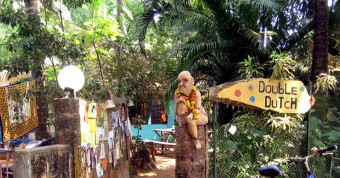A village shrouded by History
The Temple of Saptakoteshwar was constructed in the 12th century by the kings of the Kadamba dynasty. It was destroyed by the Sultan of the Deccan in the middle of the XIV century and reconstructed at the same locality by Madhava Mantri of Vijayanagar.
If the city of Old Goa was proclaimed as the Rome of the East, mind Naroa, the Kashi of the West, lay just across the Mandovi River on the island of Divar. It claimed its blessed status due to the confluence of three branches of the Mandovi that flowed by the village. The Hindus called this confluence the tirth (holy water), that washed away their sins after a dip in its waters. Naroa was also home to the Temple of Saptakoteshwar that was held in high reverence by the Hindu populace, not just the locals but from far and wide. Once a bustling place of pilgrimage, the village of Naroa now seems lost, its many secrets, on the verge of submerging into the waters of the Mandovi.
Naroa has a population of barely a thousand people, with about 80 houses dotting the tiny village. A prawn farming unit in the village is run by an entrepreneur from Calangute. A marine dock has been adapted to manufacture fibre speedboats that are even being exported. There’s also a thriving sand extraction business in the waters around Naroa, with trucks regularly plying in and out of Divar.
The exodus of Catholic youth to foreign lands has reflected in Naroa too. In Kharivaddo, one of Naroa’s wards, almost 90 percent of the Catholic boys have moved to the UK and other countries. The men folk working on board ships and in the Gulf have bettered the economy of the village, but many beautifully built houses also remain closed, their owners having migrated abroad.
“The only problem is that we don’t have a bridge,” says Seby Dias, popularly known as Seby de Divar for his role as an actor in Konkani tiatr. “But the good side of that is that we live in peace, ther are hardly any robberies.”
Unique sanctum of the Candelaria Chapel
Beneath this sleepy Naroa of modern times lies centuries of significant archaeological history.
Rui Gomes Pereira writes on Naroa’s history in his book ‘Goa: Hindu Temples and Deities.’?“The Temple of Saptakoteshwar was constructed in the 12th century by the kings of the Kadamba dynasty. It was destroyed by the Sultan of the Deccan in the middle of the 14th century and reconstructed at the same locality by Madhava Mantri of Vijayanagar at the close of the same century. It was again destroyed by the Portuguese in the year 1540 or 1541.”
During the colonial rule, it was not uncommon for sacred Hindu objects to end up in not so sacred locations. After the destruction of the temple of the Village of Naroa, its Shivalinga was placed on the wall of a village well where it remained for many years.
“Narayana Surya Rau Sar Dessai, an ancestor of the Surya Rau Sar Dessai mahajans, took that linga to Latabarcem of Bicholim where it remained for two years before being transferred to Hindalem, which later was called Naroa after the place where the deity belonged,” writes Pereira. Marks can still be seen on this linga, caused by the friction with copper vessels used for drawing water at its earlier location.
Carvings on the ancient water tank
The tirth too was shifted to the other side and that is where the Hindus converge in large numbers for ablution of sins on the day of Astami. The old tirth is called porne tirth and one finds a small Hindu shrine built there. However, on the foundations of the old Saptakoteshwar temple, a prayer and catechism house was constructed in 1563, which was later transformed into the chapel of Our Lady of Candelaria. The sanctuary of this chapel is round and topped by a dome, which is a unique character found in only two other chapels in Goa.
The peaceful ferry wharf that connects the taluka of Tiswadi to Bicholim was once a hostile border between the Portuguese and the kingdom of Bijapur. Hence a fortress was erected to guard this entry point. Though the fortress is in ruins, the old garrison church adjacent to the fortress still serves the locals. The church contains many graves, perhaps of its gallant Captains who now sleep peacefully, as all hostilities are put to rest!
The Jesuit priest Moren de Souza writes about the history of the Naroa church in his book, “Tisvaddecheo Igorzo”. During routine inspection, one Portuguese commander found the fortress of Naroa practically empty. It seemed that being a Sunday, the entire garrison had gone to a neighbouring church for Sunday services! To solve this problem, the officials decided to construct a church there. Accordingly, the king of Portugal wrote a letter dated 8th March 1546 to Dom Joao de Castro and instructed him to build a church at Naroa and dedicate it to St. Thomas the Apostle. A document dated in the year 1710 reveals that Diogo da Silveira, captain of the fort of Naroa built this church. Though the church is dedicated to the Holy Spirit, a statue of St Thomas adorns the main altar.
Fr. Feroz Fernandes of the Society of Pilar spent his childhood at Naroa, and he reveals some more secrets from his village. He leads the way from the ferry point till he comes to a cross, built right on the edge of the river. He says, “This ward is called Tarir, where all the vodekar (boatmen) of the area reside. They would sing the litany of this cross by standing in their own canoes in the river. It was believed that if the cross ever got submerged, the water would enter their homes. So to protect them from this calamity they would conduct the litany.”
He moves on to another cross and explains, “At this spot special litanies are held on the eve of major festivals. After the litany, the members would hold an auction of the mutiche poishe (fistful of money). The mutiche poishe consisted of coins contributed by members as token offerings to the cross. These coins would be gathered in a handkerchief and auctioned off. The lucky bidder would say “Mut hadli” and would devoutly keep the mutiche poishe at home.”
Local elders try to explain their customs, “When these people were converted, they retained their core customs – this is something similar to the maand (gathering place in village). The local people had their own way of worship which Christianity could not accommodate. So they chose a very remote place, used the symbols of Christianity and continued with their traditions. Wherever there was a maand, now there is a cross. Christians tried to express their faith, using the symbol of Christ and yet retaining their customs. However, at some point of time these practices were not understood and eventually forbidden. Now we should see it in a new light?that people wanted to retain something of their own.”
In the same locality lies the recently constructed temple of Daad. A little ahead, Fr. Feroz points out to a man-made cave, outside which some saffron flags are seen fluttering, a sign of the abode of a spirit. Another natural cave awaits nearby, which according to Fr. Feroz, is connected by a tunnel going deep into the hill side. A natural spring with an enclosure is hidden from view by the undergrowth. Closer inspection reveals the structure of the enclosure to be decorated with finials, indicating that this was perhaps the bathing place for the Deao (Dean of the village), whose erstwhile palace is located on the plateau just above.
The only site that has attracted government attention is the ancient water tank, which is carved out of laterite. Its walls have decorative recesses resembling those of Buddhist shrines. This tank which was buried under debris was recently excavated and cleaned. A small board proclaims it to be a ‘protected site’. Sadly, the rest of ancient Naroa remains buried under the sands of time!
.
.
.






